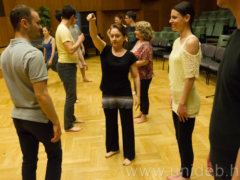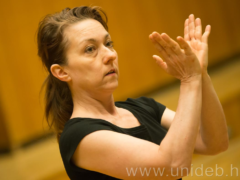The method called “the musicality of motion” tries to find the foundations of musical communication, the connection among time, energy, space, breathing, rhythm and dynamics through simple motions, that is, through physical movements of the body. The method was developed at the music academy in Amsterdam by Virág Dezső dance artist, who combines modern mime, dance, instant compositions and music in her performances. Its goal is to establish a presence for musicians and students that does not focus exclusively on the ear.
– Many think that I teach young people how to move their bodies in order to better express the message of music. But in fact it is basically about waking up consciousness and sensation. Through movements that are easy to execute we try to feel where a motion starts from and where it ends, what are the factors that affect its quality and how, and anyway, if I just stand still, doing nothing, what does presence mean, what meaning does it convey – explains Debrecen-born Virág Dezső.
Students participating in the programme can improve not only in solo presentation, but in small-stage play, too, because they learn a series of exercises that help concentrate through the body, facilitate playing together and keeping track of others through making clear choices and decisions.
Virág Dezső has worked with performers of the present and the future for ten years. First she worked with singers in Amsterdam, teaching them “physical acting”. In time, demand for her method among instrumentalists and composers started to grow, so 5 years ago she developed the programme called “the musicality of motion”, which has since also been chosen as a research topic by students participating in a masters programme at the music academy in Amsterdam.
– According to my experience, singers tend to be more controlled and cautious, while instrumentalists are more prepared to take risks and experiment. For example, when I work with students or musicians who play old music, I feel enormous freedom and an urge to improvise. Of course, it matters whether someone studies to become a conductor or a musician playing a wind instrument or a percussionist. There are differences, but the point is always the same: communication through a chosen piece. And I try to help them learn this – says Virág Dezső.
In Hungary, the performer teaches only at the Faculty of Music of UD, where she leads a two-semester programme. In the last two years she has also been an invited teacher at the Summer Academy of Young Musicians, a traditional event held in July at UD. This year she will participate in the programme again, which will be held between 15 and 24 July. Those interested can register for her course at ymsa.unideb.hu.
Press Office, unideb.hu




































